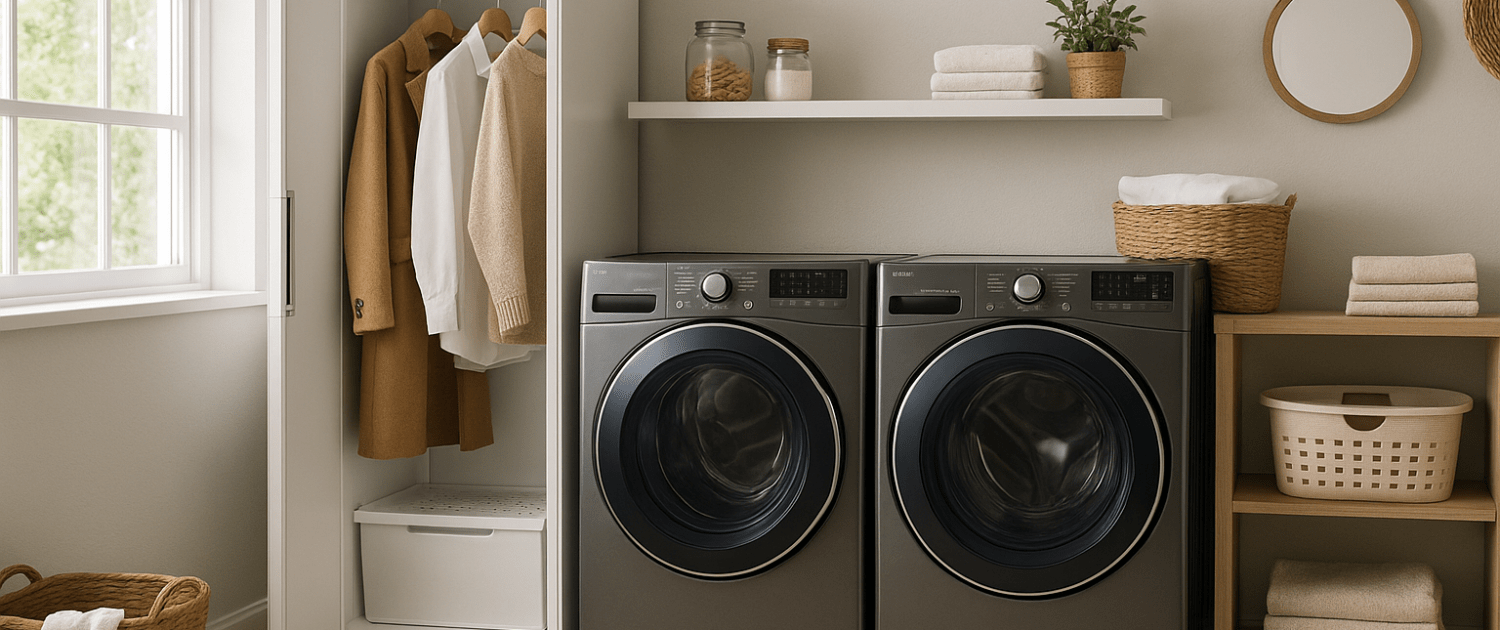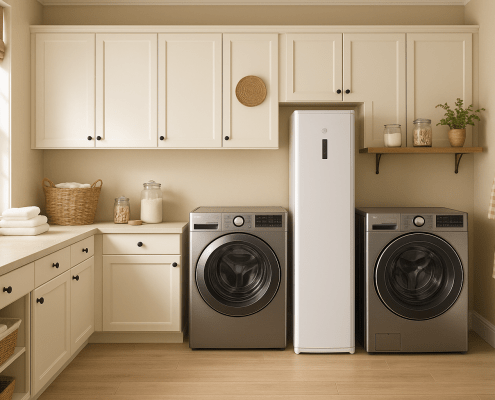Laundry Steam Closet Drain Clogged? Here’s How to Fix It
Steven E / Monday July 7, 2025
Like any appliance that uses water, your laundry steam closet needs somewhere for all the moisture to go. Inside every steam closet is a drain system that collects and removes condensed steam. If that drain becomes blocked, you might notice standing water in the tray, excess humidity inside, damp clothes, or error messages during a cycle.
Fortunately, clearing a blocked drain in a laundry steam closet is a straightforward task. We’ll show you how to find the drain, clean it thoroughly, and get your steam closet back with simple tools you already have at home.
The information in this article may not apply to your specific appliance model. We recommend consulting your manufacturer’s documentation or contact us with any questions.
Why Your Steam Closet Has a Drain (And Why It Matters)
Your steam closet creates a lot of hot, moist air to refresh your clothes, but that moisture has to go somewhere. It condenses into water, and that water is collected and drained away.
When the drain gets clogged, you end up with:
- Puddles of water in the bottom tray
- Damp clothes even after a full cycle
- A damp, musty smell inside the closet
- Longer cycles and poor performance
That’s why keeping the drain clear is so important. Luckily, it’s one of the simplest fixes you can do.
What You’ll Need
You don’t need much to get this job done, just a few things you probably already have:
- A small bucket or a few towels
- Warm water with a little dish soap
- White vinegar (optional, but great for hard water deposits)
- A flexible brush, pipe cleaner, or even an old toothbrush
- A microfiber cloth
- A flashlight to help you see what’s going on
Step 1: Unplug the Steam Closet
First things first: unplug it. Even though you’re just cleaning, you’ll be working around moisture, so better safe than sorry.
Step 2: Find the Drain
Next, figure out where the drain actually is. On most steam closets, you’ll find it:
- At the very bottom of the chamber
- Behind or under the removable water tray
- In one corner of the floor, under a little grate or cover
If it’s not obvious, pull out the tray and look closely; your manual can help if you’re unsure.
Step 3: Get Rid of Any Standing Water
If there’s water pooled in the bottom, soak it up with towels or use a small cup or baster to scoop it into a bucket. Makes it way easier to see what you’re doing.
Step 4: Check for Obvious Blockages
Take a good look inside the drain opening. Shine your flashlight down there. You might see lint, dust, hair, or even little bits of fabric that somehow worked their way in.
Use your fingers, a pipe cleaner, or your brush to gently pull out whatever you can reach. Be careful not to jam anything deeper in there; you want to remove the gunk, not shove it farther down the pipe.
Step 5: Flush It Out
Mix a little warm water with a few drops of dish soap and pour it slowly into the drain. Watch how fast it drains:
- If it flows right through, you’re probably good.
- If it drains slowly or backs up, you’ve got more work to do.
For hard water deposits, you can also pour in a mix of half vinegar and half water, then let it sit for 10–15 minutes to break things up.
Step 6: Brush It Clean
Still clogged? Grab that flexible brush or pipe cleaner and gently work it into the drain opening. Wiggle it around and pull it back out, wiping off whatever you catch.
If you can, feed the brush in a little farther to clear anything deeper in the drain line. Rinse with more warm water when you’re done to flush out the loosened debris.
Repeat this process until the water flows freely and drains quickly.
Step 7: Clean the Tray and Grate
Don’t forget about the water tray and any little cover or grate over the drain. Wash them with warm, soapy water, wipe them dry, and put them back in place.
Step 8: Test It Out
Plug your steam closet back in and run a short cycle without any clothes just to make sure everything’s working properly. If it all looks good, you’ve officially fixed your drain.
Tips to Keep Your Drain Clear
Now that your drain is clear, keep it that way with a few easy habits:
- Wipe down the inside of the closet after each use.
- Check the drain opening every couple of weeks for lint or residue.
- Empty and clean the water tray regularly.
- Once a month, pour a little vinegar and warm water down the drain to prevent buildup.
- Don’t overload the closet, it generates more moisture and more lint.
What If It Still Seems Clogged?
If you’ve done everything above and water still isn’t draining properly, the clog might be deeper in the hose or line.
Here’s what you can do:
- Pull the steam closet away from the wall and find the drain hose at the back or bottom.
- Check that it’s not kinked, pinched, or bent.
- Disconnect it carefully and flush it through with water and vinegar.
- Run your flexible brush or a small drain snake through the hose to clear anything stuck.
Reconnect everything, and you’re good to go.
Final Thoughts
A blocked drain in your laundry steam closet can be a hassle, but it’s one of the easiest fixes you can tackle yourself. With just a little time and a few simple tools, you can get your appliance draining properly and keep your clothes fresh, dry, and ready to wear.
So don’t let a little standing water or damp clothes get you down, roll up your sleeves, follow these steps, and get your steam closet back in top shape today. You’ve got this.
Where To Find Us
If you need any replacement parts for your appliances, you can enter your model number at AppliancePartsPros.com to locate and order them quickly. Most orders arrive in just two business days, and we have tons of great information in our repair help section and YouTube videos to help you troubleshoot.
Stay connected with the latest DIY tips, tutorial videos, and repair guides by following us on Facebook, Instagram, and Twitter. We love hearing about your repair stories and successes. If you need more help or want personalized guidance, feel free to reach out. We’re ready to help you take on your next project with confidence!
With nearly a decade of experience in providing top-notch customer service regarding appliance parts and repair, Steven enjoys sharing practical advice, troubleshooting tips, and interesting information to help readers stay informed.





